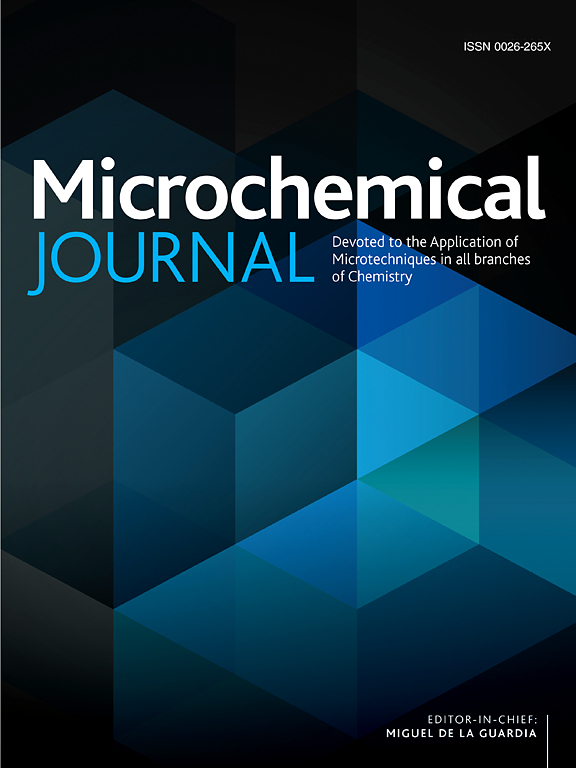酚类深共晶溶剂有效提取大豆油脱臭馏出物甲酯中的生育酚
IF 4.9
2区 化学
Q1 CHEMISTRY, ANALYTICAL
引用次数: 0
摘要
天然生育酚主要由植物油脱臭馏出物生产。开发简单、绿色的提取方法是分离天然生育酚的迫切需要。本文首次建立了一种绿色、快速、温和(室温)的基于酚醛深共晶溶剂(DES)的溶剂萃取方法,从豆油脱臭馏出甲酯(SODD-ME)中同时提取生育酚三种异构体(α-、γ-、δ-生育酚)。以四丁基氯化铵基DESs (TBAC-DESs)为萃取溶剂。考察了各因素对三种个体和总生育酚提取效率的影响。确定了最佳提取条件:DES由TBAC和4-甲基苯酚组成(摩尔比为1:1),DES/SODD-ME 6:1 (w/w),己烷/SODD-ME 1:1 (w/w),室温下涡流辅助提取1 min。在此条件下,总生育酚的最大提取率为(97.5±0.5)%。酚类DESs的分子结构对SODD-ME中α-、γ-和δ-生育酚的提取选择性有显著影响。tbac -酚DESs通过氢键和π -π相互作用将三种生育酚结合在一起。本文章由计算机程序翻译,如有差异,请以英文原文为准。
Effective extraction of tocopherols from soybean oil deodorizer distillate methyl esters using phenolic deep eutectic solvents
Nature tocopherols are mainly produced from vegetable oil deodorized distillates. And development of simple and green extraction method is highly desirable for nature tocopherols separation. In this work, a green, rapid and mild (room temperature) solvent extraction method based on phenolic deep eutectic solvents (DES) has been developed to simultaneously extract three isomers of tocopherols (α-, γ-, δ-tocopherol) from soybean oil deodorizer distillate methyl esters (SODD-ME) for the first time. Tetrabutyl ammonium chloride-based DESs (TBAC-DESs) were used as extraction solvents. The effect of factors on the extraction efficiency of three individuals and total tocopherols was investigated. The optimal extraction conditions were determined as follows: DES composed of TBAC and 4-methylphenol (molar ratio of 1:1), DES/SODD-ME 6:1 (w/w), hexane/SODD-ME 1:1 (w/w) and vortex-assisted extraction of 1 min at room temperature. Under these conditions, the maximum extraction efficiency of total tocopherols was (97.5 ± 0.5)%. And the molecular structure of the phenolic DESs had significant effect on the extraction selectivity on α-, γ- and δ-tocopherol from SODD-ME. The underlying extraction mechanism was that the TBAC-phenol DESs combined the three tocopherols by both hydrogen bonding and π–π interaction.
求助全文
通过发布文献求助,成功后即可免费获取论文全文。
去求助
来源期刊

Microchemical Journal
化学-分析化学
CiteScore
8.70
自引率
8.30%
发文量
1131
审稿时长
1.9 months
期刊介绍:
The Microchemical Journal is a peer reviewed journal devoted to all aspects and phases of analytical chemistry and chemical analysis. The Microchemical Journal publishes articles which are at the forefront of modern analytical chemistry and cover innovations in the techniques to the finest possible limits. This includes fundamental aspects, instrumentation, new developments, innovative and novel methods and applications including environmental and clinical field.
Traditional classical analytical methods such as spectrophotometry and titrimetry as well as established instrumentation methods such as flame and graphite furnace atomic absorption spectrometry, gas chromatography, and modified glassy or carbon electrode electrochemical methods will be considered, provided they show significant improvements and novelty compared to the established methods.
 求助内容:
求助内容: 应助结果提醒方式:
应助结果提醒方式:


